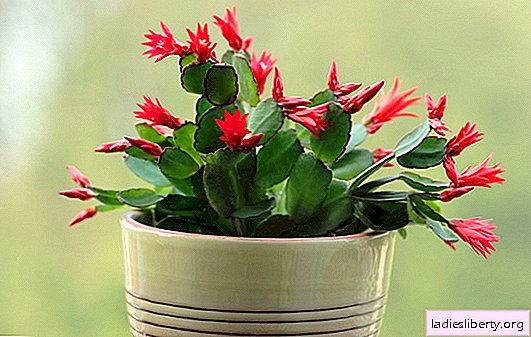
The botanical name for the Decembrist or Christmas is Schlumberger.
Its peculiarity lies in the fact that, despite belonging to the genus of cacti, caring for it at home is significantly different.
Also, a peculiar highlight of the zygocactus is its flowering at Christmas.
How to achieve this, and what other necessary conditions exist, you will learn from our article.
Decembrist: home care - reproduction
Decembrist belongs to the genus of South American zygocactus. The name comes from the flowering period. This is the end of November - the beginning of February - the time when summer is in the rainforests. It belongs to the family of centenarians and can please you for 15 years. It is believed that this plant is unpretentious in care, and even beginners can carry out the reproduction process.
The most common way (and for some even the only one) is reproduction cuttings. The best time for this is May or the time when the flower blooms. Schlumbergera differs in that it easily forms aerial roots. At the very beginning, it is necessary to unscrew the handle with two processes (yes, just unscrew) from the mother plant. Do not use a knife or scissors for these purposes. By turning the segment around its axis, you can easily separate it from the shoot. Then it is necessary to leave the stalk dried in air (we are talking about the time from several hours to two days). Next, place the stalk in sand, perlite, vermiculite (sand substitute) or soil so that it releases the roots. You can do this in water, and for the best effect, use root, a special tool to accelerate root growth. After a month, you can see the emergence of the segment - this will mean that the rooting was successful and you can transplant the plant into the ground. Also, cuttings can be planted immediately in the ground and covered with a jar to create a greenhouse effect. Most flower gardeners agree that zygocactus cuttings take root well.

Planting the cuttings
Also, one of the methods of reproduction is graft. It is used relatively rarely, mainly to obtain the standard form of zygocactus. Reproduction technology is as follows. The top of the Peirescia cactus (the plant to be grafted) is cut with a knife. The remaining stem is slightly split and a zygocactus segment of several segments is inserted into the resulting hole. The specified place is fastened together and tied with a thread. After the young plant develops the crown, the thread is removed, the leaves are broken off on the peirescia. The resulting plant itself is tied to a peg to avoid breaking off. For planting, an equivalent soil composition is used from a mixture of turf, sheet soil and sand.
An important part of caring for Decembrist at home is his transfer. It is produced immediately after flowering, i.e. in the month of February. It is recommended to carry out this procedure for a young plant - every year, and for an adult, such a need arises - every 4-5 years. Pot select wide and short. Fill it a third with drainage, and then fill it with prepared or purchased soil mixture, evenly distributing it over the pot. Watering is necessary one day after drying of the top layer.
Decembrist: home care - soil, lighting, flowering conditions
Soil: it is recommended to use light, nutritious, with good drainage. According to its properties, it should be air- and water-permeable. The ideal is a mixture of peat and sheet land with the addition of sand. You can also mix 1 part of turf land, 1 part of sand, 2 parts of leafy land. Such a universal composition: leafy, humus, turfy earth (6: 4: 1) plus peat and sand (2: 2)
For disinfection, add crushed coal, and for better water permeability, do not forget to put brick chips or expanded clay. The soil for the Decembrist should be slightly acidic.
The most important aspect when growing a Decembrist is that he does not tolerate direct sunlight. His place of residence should be bright, but a little shaded. Otherwise, the segments will begin to weaken and turn gray-green.
The home Decembrist is quite tolerant of the temperature regime, its optimal degrees are 18-25 ° C. A feature of zigocactus is that in summer it is better to take it to fresh air (to the balcony or to the garden).
Decembrist is a plant that can be grown as usual, but it represents a greater effect as ampelous. To do this, trim it, in which the excess parts are not cut, but unscrewed manually. This is achieved not only the appearance of the flower, but also its abundant flowering.

Pinching a segment
After flowering, Schlumbergera needs loneliness. During this period, it is better to transfer it to a room where the temperature does not exceed 12-15 degrees, and minimize watering. Feeding is also worth stopping. If you want to achieve the flowering of the Decembrist by Christmas, then he needs to ensure careful care at home.
How to make a Decembrist bloom: in mid-November, return the plant to a warm, bright place and increase the amount of incoming water, helping the plant wake up. Try to rotate the plant around its axis so that it is evenly lit from all sides. If the buds appear on one side, then it means it was better lit than the rest. But do nothing already, but draw conclusions for the next time. An important rule: as soon as buds begin to form on the flower, i.e. the period of budding will begin, it is impossible to rearrange it from place to place and you can not even turn the pot with the plant. Otherwise, the Schlumberger may panic and discard the buds. Your flower itself will feel when it is time for it to bloom. And you must provide him with all the conditions for this.
Decembrist: home care - top dressing and watering
Since March zygocactus needs monthly top dressing complex fertilizer. To do this, you can use liquid complex fertilizer. In the summer season, when the stems begin to grow intensively, plant nutrition should be carried out twice a month. Around September, fertilizer saturation is recommended to be discontinued. Preventive treatment with fungicides - drugs that prevent or kill various bacteria - pathogens, will not interfere with the plant.
Watering should be moderate, preferably warm water. From mid-spring to September, you need to moisten the flower, and during flowering, increase watering. The necessary hydration is achieved by spraying or by placing the pot on a pebble pan.
The plant does not like plentiful watering. If the soil is constantly wet, the root system will quickly rot. In this case, reviving the Decembrist is quite difficult. First of all, you need to remove the rotten roots and change the soil. Usually it consists of equal parts of peat, sand, brick chips and thin sheet earth.
The plant loves moist air, so do not be lazy to spray it at least once a day.
Tip: try to bloom around the trunk with snow (or ice from the refrigerator) during the flowering season. This will help extend the flowering period.
Based on the foregoing, Decembrist Care Calendar at home will look like this.
Spring. We carry out a plant transplant around the end of April-May.
Summer. We take out to fresh air. We hide from the bright and direct rays of the sun, increase watering, spray with warm water.
Autumn. Getting ready for flowering. Reduce watering and rearrange the Decembrist in a cool place (approximately + 14ºС). In November, we transfer the plant to a warmer place and increase watering.
Winter. We carry out monthly top dressing, regularly water it. Zygocactus does not move to another place. After flowering, reduce watering and leave the plant alone until the end of March.
Decembrist: home care: why does she die?
Despite the relative unpretentiousness of this plant, Decembrist can also die if necessary care is not carried out at home.
Rotting of the roots - it occurs when the roots are very moist. Urgent transplantation will help prevent their death.
Withering of plants - can be caused by diseases.
The trunk of the plant sways - this means that the plant dies from hypothermia (watering with cold water, keeping it in a cool room) or, conversely, from overheating in the sun. A strong concentration of fertilizers can burn the roots. In this case, transplant the plant into another substrate.

Leaf diseases
The segmented segments of the stem crumble - the cause may be a defeat spider mite or nutrient deficiency (depleted soil, lack of top dressing). In this case, spray the zygocactus with a solution of fertilizers for epiphytic cacti or apply them under the root. In extreme cases, you can change the soil. Also, dry air can become a cause of falling.
Stress, to which the plant may be exposed, may also be the cause of its death. Avoid sudden changes in temperature, drafts, changes in environmental conditions. Transplant on time using all the necessary conditions.
Stress also refers to the standard situation in which we bring an acquired plant home. Let it not upset you if, in this case, Schlumbergerer will throw off the light pink buds at the ends of the leaves. So she goes through a period of adaptation. Also, carefully consider the flower you are purchasing. The segments on it should not be transparent in color with incomprehensible spots. Try and plant stem. It must be whole, strong and healthy.
Decembrist may also be amazed fungal diseasessuch as phytium, fusarium, late blight. The most common of these diseases are transmitted from an already infected bush. The use of fungicides from the triazole group, or the presence of benomyl, chlorothalonil, will help get rid of such diseases.
Spider mites pose a threat from insects. They can appear if the plant is not kept in sufficient air humidity. From touching them, the leaves of the plant turn red, yellow or brown. In this case, a variety of insect pests, Actellik, Fitoverm or Neoron, will help.
If you believe in signs, then growing a Decembrist and caring for him at home is for you.
It is believed that to its owners, it helps to prevent diseases of the gallbladder and adrenal glands, as well as get rid of insomnia, allergies and lower blood pressure.
Also, this flower takes on all the negative energy of the room and transforms it into a favorable aura.
This is so important for our home, isn't it?











